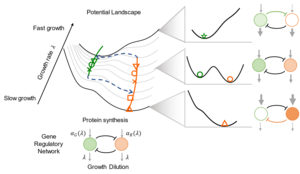A new study has found that cellular growth rate affects the cell-fate-decision landscape. Researchers used a synthetic genetic circuit, the toggle switch, to study the extent to which cellular growth rate affects the phenotypic states of the cell. They discovered that gene expression response to growth-rate variations was unbalanced, leading to a growth-rate-dependent phase transition between the available phenotypic states of the toggle. The steady states bifurcate at a critical value of the cell’s growth rate, and the researchers proposed a mathematical model that explains the bifurcation arising from the unbalanced relationship between gene expression and growth rates. The study has revealed a global regulation mechanism that is ubiquitous in any genes in the cell-fate-decision network and can promote the bifurcation of cell phenotypic states. With the aid of quantitative synthetic biology, researchers can reconstruct orthogonal networks that insulate host genetic networks to evaluate how growth rate affects gene expression and how they promote the bifurcation of cell phenotypic states. The study highlights the importance of understanding and predicting the cell-fate-decision process using network topology in a bottom-up manner.
A recent study published in Nature Chemical Biology has shed light on how cellular growth rate affects the cell-fate-decision landscape. The research group, led by Prof. FU Xiongfei from the Shenzhen Institute of Advanced Technology (SIAT) of the Chinese Academy of Sciences (CAS), used a synthetic genetic circuit, the toggle switch, as a model to study how cellular growth rate affects the phenotypic states of a cell. The researchers found that gene expression response to growth-rate variations was unbalanced, resulting in a growth-rate-dependent phase transition between the available phenotypic states of the toggle.
The steady states bifurcate at a critical value of the cell’s growth rate, and the researchers also proposed a mathematical model that explains the bifurcation arising from the unbalanced relationship between gene expression and growth rates. Prof. FU, the corresponding author of the study, further verified the model’s capabilities by constructing toggles with tuned intrinsic parameters and successfully predicting their steady-state properties.
The study has revealed a global regulation mechanism that is ubiquitous in any genes in the cell-fate-decision network and can emerge or program a new gene expression pattern with a spatiotemporal order. This mechanism doesn’t rely on specific regulatory factors and can promote the bifurcation of cell phenotypic states. However, it is hard to disentangle the global factors, such as growth rate, from the cell-fate-decision processes, and the growth rates can be varied as the results of the fate decision, making it a chicken and egg decision.
With the aid of quantitative synthetic biology, researchers can reconstruct orthogonal networks that insulate host genetic networks to evaluate how growth rate affects gene expression and how they promote the bifurcation of cell phenotypic states. The study has shown how global regulation factors, such as cellular growth rate, can reshape the cell-fate-decision landscape, and it highlights the importance of understanding and predicting the cell-fate-decision process using network topology in a bottom-up manner.
Don’t miss interesting posts on Famousbio










